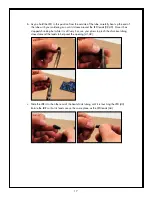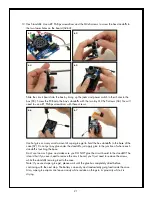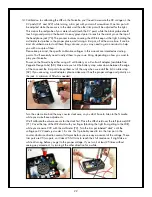
23
72
73
Next, we’ll calibrate the volume sensor for the light. Remove the shield from the LDR. Keep the
meter probes in the same locations. While the LDR is in the light, the voltage on CV2 should be
just under 4.9 volts, so adjust the trim pot labeled “light” until so you read this voltage at the test
point (73). It may take turning the trim pot several times in the counter-clockwise direction to get
this voltage. Now the volume control sensor should be calibrated. When you cover the sensor
with your hand, the Noisette’s LED should be dark and when you move your hand to let the light
shine on the sensor, the LED should be bright.
Now we can calibrate the pitch sensor. We’ll do this the same way that we calibrated the
volume sensor. First, we’ll calibrate it for the dark. Place the LDR shield on the LDR and put the
red probe on the CV1 test point. Keep the black probe in the same location on headphone jack.
While keeping your finger mostly covering the LDR, turn the “dark” trim pot until the voltage on
CV1 reads no higher than around .8 volts. Counter-clockwise increases the voltage and
clockwise decreases the voltage. Once again, you may need to turn this pot lots of times until
you see any change in voltage. If the voltage never changes, then try turning it the other
direction multiple times.
Finally, we’ll calibrate the pitch sensor for the light. Keep the LDR shield and the probes in the
same place, but don’t cover the LDR with anything. Adjust the “light” trim pot until the voltage on
CV1 reads just under 5 volts or so. Counter-clockwise for more voltage and clockwise for less
voltage.
SOME THEORY IN SETTING THE TRIM POTS
Once again, these trim pot settings are intended as starting points, just to get your Noisette
working for you. We encourage you to play around with the settings until you’ve found
something that works best for you and how you like to play. For the most accuracy in pitch and
volume, you’ll need to adjust the sensor calibration for the widest range of hand motion.
It’s important to do the calibration routine in the type of ambient light conditions that you intend
to use your Noisette, otherwise the dynamic range of the sensors will be greatly limited. The
idea is to use the brightest light that you expect the Noisette will ever see to calibrate the “light”
trim pot, and the darkest conditions that the Noisette will ever see to help calibrate the “dark”
trim pot. If you plan to play your Noisette with your fingers, please keep in mind that fingers are
somewhat translucent (they allow some light through), so consider that when calibrating for dark
conditions.
For the CV1 (pitch sensor), it’s generally best to have the widest range of voltage as possible,
corresponding to the widest range of light the pitch sensor will ever see. The voltage limit on the
upper end of that range is 5 volts, so in a very bright environment, try to adjust the “light” trim








































